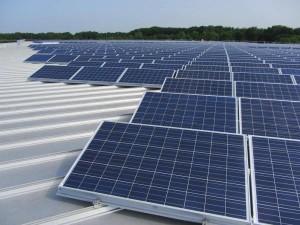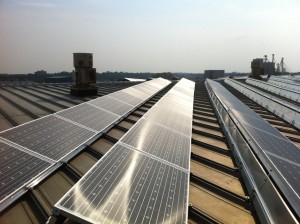Low-pitched metal roofs can successfully support solar modules when they’re angled just right. Advanced Racking Solutions manufactures tilted systems that happen to work perfectly on metal rooftops.
Metal rooftops are found atop a wide range of buildings — family homes, storage warehouses, large industrial shops, sports arenas, you name it. All metal rooftops must be pitched, and large metal rooftops are considered “low-pitch” because they’re at angles less than 10°. The process of installing solar on these large metal rooftops is not so much of an issue as the fact that low-slope rooftops need modules tilted to get the most production. Advanced Racking Solutions focuses exclusively on manufacturing solar mounting solutions for low-pitched metal rooftops to solve the tilt problem.
 “Because there’s a pitch to the roof, the traditional way of putting solar on a metal rooftop is to put it flush-mount on the south side, meaning parallel with the roof surface, and put nothing on the north side,” says Eric Stephenson, director of engineering and technology. “For low-pitched metal roofs, we developed a tilted solution, which would allow you to put solar on both the south and the north. It opens up the other half of the roof to rooftop solar.”
“Because there’s a pitch to the roof, the traditional way of putting solar on a metal rooftop is to put it flush-mount on the south side, meaning parallel with the roof surface, and put nothing on the north side,” says Eric Stephenson, director of engineering and technology. “For low-pitched metal roofs, we developed a tilted solution, which would allow you to put solar on both the south and the north. It opens up the other half of the roof to rooftop solar.”
Flush-mount systems are not ideal for low-pitched metal roofs because their low tilt angles subject modules to snow cover and general poor yield since they’re almost horizontal. Heat buildup is also a big problem underneath the modules.
“With our titled solution, it’s vented and allows the heat to escape,” Stephenson says. “And because it’s tilted, you have a small aisle between each row. There’s no more climbing over top of the modules to get access to modules in the middle of the array.”
The two common types of metal roofs include an exposed fastener roof and a standing-seam roof. Exposed fastener roofs or corrugated steel roofs screw sheet metal into the structure, so fasteners are exposed. Advanced Racking manufactures the VICERAIL system for exposed fastener roofs and uses an EJOT fastener to penetrate the roof. The fastener is then sealed to make it water-tight.
Most of Advanced Racking’s work is on standing-seam rooftops. A standing-seam roof has a rib or seam that stands up generally every 2 ft. Roof panels meet together and roll into a weather-tight seam without using any fasteners.
“That seam presents a continuous knob that you can grab onto,” Stephenson says. “We use the S-5! clamp to connect the racking system to the roof. We took a version of our ballasted racking system and adapted it to use the S-5! clamp to clamp onto the seams.”
 Advanced Racking’s VICERACK system’s ability to clamp onto the seams allows the system to be installed without ballast. As with any flat-rooftop solar project, the biggest obstacle is often ensuring the building can support an additional load. Not needing ballast with the Advanced Racking system is helpful for design.
Advanced Racking’s VICERACK system’s ability to clamp onto the seams allows the system to be installed without ballast. As with any flat-rooftop solar project, the biggest obstacle is often ensuring the building can support an additional load. Not needing ballast with the Advanced Racking system is helpful for design.
“What was critical for us is that we have a system that would be benign as far as the wind loading was concerned,” Stephenson says. “The additional wind load on the building would make the project undoable. We spent a lot of time in the wind tunnel to make sure that we had a system that would not add any additional wind loads to the structure. We were able to achieve that.”
The type of material you place on top of a metal rooftop requires attention, too.
“All of [Advanced Racking’s] racking members are aluminum and the fasteners are stainless steel,” Stephenson says. “The aluminum is primarily for corrosion resistance. It’s also compatible with the types of coatings on rooftops. Standing seam rooftops are often finished with galvalume, a combination of galvanizing and aluminum coating. Having an aluminum racking system avoids some of the problems that come with dissimilar metals.”
Advanced Racking’s systems are almost entirely shop-assembled, so work on top of the roof is minimal. Very few tools are needed to install the S-5! clamps in the case of a standing-seam rooftop installation.
Metal rooftop mounting and racking systems from Advanced Racking Solutions are easy enough to install, but Stephenson says the real obstacle in gaining larger acceptance is changing people’s views on how solar works on metal roofs.
“One of the challenges that people have with low-pitched metal roofs is that a flush-mount system is not a great solution,” he says. “When people see that there is a better solution for a low-pitched metal roof, they will start to look differently at rooftops that are out there. Roofs that were previously overlooked or not looked at very favorably will become a lot more appealing.”
— Solar Builder magazine
[source: http://www.solarbuildermag.com/featured/metal-rooftops-solar-racking/]

Leave a Reply
You must be logged in to post a comment.